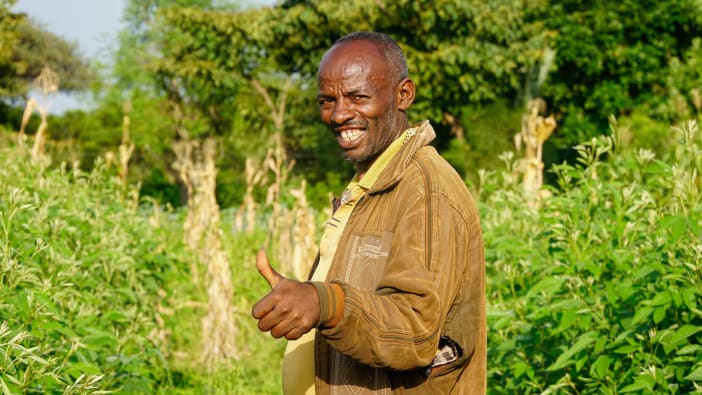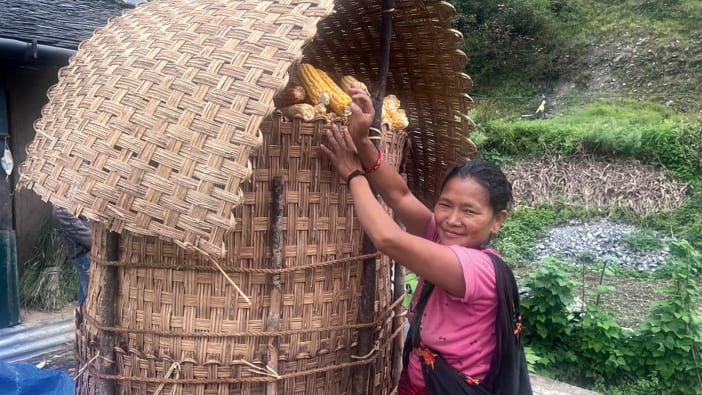WARNING!
Take great care in producing and using natural pesticides. Use an old pan no longer used to cook food and keep well away from children. Wear plastic gloves or bags over the hands.
Any crop treated with natural pesticides should be washed with water before being used.
3. Natural pesticides
These pesticides are prepared from locally available plants. Most recipes have a small amount of soap added to help the solution stick to the leaves. Filter using a piece of cloth or sacking.
Apply the pesticides at or just after sunset to cause as little damage as possible to helpful predators. Use a sprayer or watering can, or soak a leafy branch in the solution and sprinkle the plants.
Recipes for natural pesticides…
Tobacco
- Take two handfuls of dry leaves (200gm) or cigarette ends.
- Boil for 15 to 20 minutes in 2 litres of water.
- Add soap, mix and let cool before filtering.
- Dilute with 5 litres of water.
Apply once a week.
Effective against maize stalk borer, cutworms, caterpillars, aphids, flies and weevils and also against ticks on livestock.
Red chilli peppers
Chop up a cup of red chilli peppers. (Be really careful not to rub your eyes!)
- Add 2 litres of water.
- Either leave to stand in the water for 2–3 days or boil for 15 minutes.
- Add soap powder or shavings, mix and filter.
During dry weather, apply once a week. During rainy weather, apply three times weekly.
Effective against caterpillars, aphids and ants.
Pyrethrum
- Dry half a kilo of newly-opened flowers.
- Crumble the dried flowers.
- Boil for 15 to 20 minutes in 2 litres of water.
- Add soap, mix and filter before use.
Effective against aphids, white fly and mealy bugs.
You can also make pyrethrum powder by pounding the dried flowers. Sprinkle around the house to kill fleas and bedbugs.
Papaya
- Take 1kg of fresh papaya leaves, 2 teaspoonfuls of kerosene and soak in 10 litres of water for 3 hours.
- Filter and sprinkle on plants..
Effective against various pests.
Wood and rice husk ash
- Collect the ashes from burnt rice husks or wood (eucalyptus and cypress are the most effective).
Sprinkle the ash around young plants. Continue to sprinkle new ash for two or three weeks until the plants are well established. Alternatively, surround the whole plot with a trench 8–10cm wide, filled with ash.
Effective against cutworms, snails, slugs and turnip moths.
Treatment for plant cuttings or suckers
This recipe produces a fungicide (preventing rotting from various fungi) and nematicide (preventing damage from nematodes – tiny worm-like creatures which eat away roots and tubers). It has been used very successfully with cocoyam suckers before planting them out. Any other kind of cutting would also benefit.
Pound together:
- 1 cup of wood ash
- 1 handful of fresh ginger roots
- 1 handful of garlic cloves.
- Add a handful of papaya leaves and pound again in one litre of water.
- Dilute this mixture with 5 litres of water and stir.
Dip suckers and shoots into the solution and allow the liquid to dry slowly in the shade. Repeat a second time. Plant the suckers as normal. Three weeks after planting, this solution can be sprinkled on the soil around the young plants.
Compiled from information from Dr Mulowayi Katembwe, AMAVIC, BP 140, Goma, Democratic Republic of Congo and the Presbyterian Rural Training Centre (PRTC), Kumba, Cameroon.












